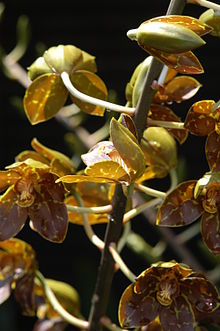Grammatophyllum speciosum
| Grammatophyllum speciosum | |
|---|---|
 |
|
| Scientific classification | |
| Kingdom: | Plantae |
| (unranked): | Angiosperms |
| (unranked): | Monocots |
| Order: | Asparagales |
| Family: | Orchidaceae |
| Subfamily: | Epidendroideae |
| Tribe: | Cymbidieae |
| Subtribe: | Cymbidiinae |
| Genus: | Grammatophyllum |
| Species: | G. speciosum |
| Binomial name | |
|
Grammatophyllum speciosum Blume |
|
| Synonyms | |
Grammatophyllum speciosum, also called giant orchid, tiger orchid, sugar cane orchid or queen of the orchids, is a species of orchid native to tropical Asia. It is listed by the Guinness Book of World Records as the world's tallest orchid, with specimens recorded up to 7.62 metres (25 ft) in height.
It is an epiphytic and occasionally a lithophytic plant, forming spectacular root bundles. Its cylindric pseudobulbs can grow to a length of 2.5 m. It can grow to gigantic clusters weighing from several hundred kilograms to more than one ton.
Each raceme can grow to a height of 3m, bearing up to eighty flowers, each 10 cm wide. The flowers are yellow colored with maroon or dark red spots. These flowers are remarkable, since the lowest flowers have no lip and these flowers function as osmophores for the entire inflorescence and continue to emit chemical scent to attract pollinators as flowers open in succession. It blooms only once every two to four years. This orchid can, however, remain in bloom for up to two months.
It is native to New Guinea, Indonesia, Malaysia and Philippines, growing in crotches of large trees on exposed areas of the lowland tropical rainforest.
A giant orchid weighing two tons was one of the highlights in the 1851 exhibition at the Crystal Palace in London.
Because of its enormous size, it is rarely cultivated as this species is usually too large to be accommodated in most greenhouses. Cultivated specimens of this species are always grown as terrestrials, as the plants grow as both an epiphyte and terrestrial in habitat.
...
Wikipedia
